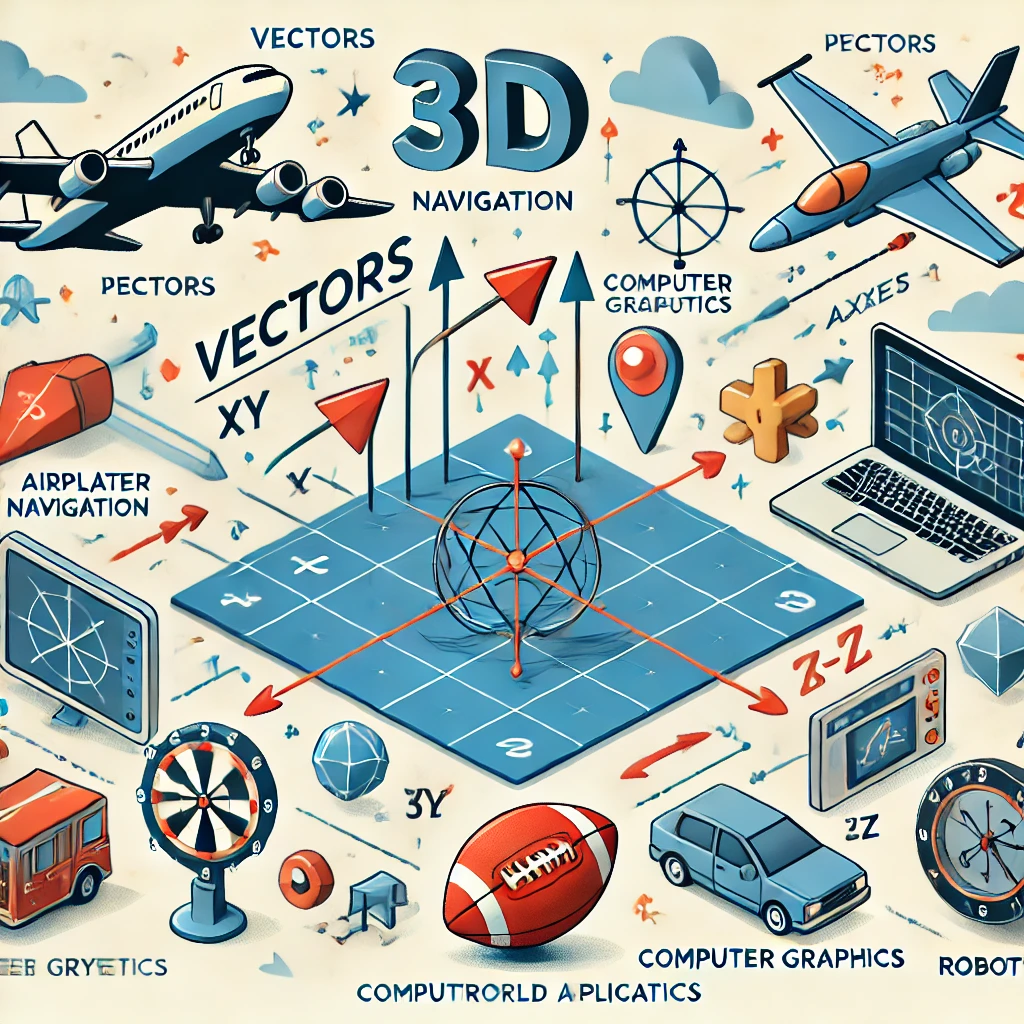Understanding Vectors: The Basics
Vectors are fundamental mathematical entities that represent quantities possessing both magnitude and direction. Unlike scalars, which are defined solely by their size (like temperature or mass), vectors offer a more comprehensive representation of various physical phenomena. For instance, velocity, which indicates the speed and direction of an object, is exemplified as a vector. This nuanced definition allows vectors to play a pivotal role in understanding motion, forces, and other directional quantities.
To grasp the concept of vectors better, it is crucial to familiarize oneself with basic terminology. A vector is often represented as an arrow—its length signifies the magnitude, while the arrowhead points in the direction. The starting point of this arrow is referred to as the “tail,” and the endpoint is the “head.” This visual representation aids in the comprehension of operations involving vectors, such as vector addition. When two vectors are added, they are typically placed tip-to-tail, leading to a resultant vector that reflects both the magnitudes and directions involved.
In many applications, we encounter the term “scalar.” Scalars are quantities that are described solely by their size; examples include mass and temperature. The distinction between vectors and scalars is critical, particularly in fields like physics and engineering, where the directional attributes of a vector can significantly influence outcomes and solutions to problems.
The relevance of vectors extends to numerous disciplines, including physics, engineering, and computer graphics. In physics, for example, they are used to calculate forces affecting objects in motion. In engineering, vectors help in analyzing loads and stresses in structures. Likewise, in computer graphics, vectors are integral in rendering images and animations, contributing to a more realistic representation of three-dimensional objects. Understanding vectors is indispensable across these domains, forming the groundwork for advanced studies and applications in both theoretical and practical realms.
3D Geometry: Our Spatial Understanding
Three-dimensional (3D) geometry is a fundamental branch of mathematics that deals with shapes and forms in space. Unlike two-dimensional geometry, which focuses on flat surfaces characterized by length and width, 3D geometry incorporates depth, allowing for a more comprehensive understanding of our surroundings. Key concepts in 3D geometry include points, lines, planes, and shapes, which collectively create the backbone of spatial understanding.
Points serve as the basic units in 3D geometry, representing a specific location in space with no dimensions. Lines extend infinitely in both directions and can be defined through endpoints in three dimensions. Planes, on the other hand, are flat, two-dimensional surfaces that stretch infinitely in length and width but have no depth. The interplay of these elements leads to the formation of 3D shapes such as cubes, spheres, and pyramids, which can be analyzed and measured using various geometric principles.
More
The applications of 3D geometry are extensive, impacting several fields in significant ways. In architecture and urban planning, understanding 3D geometry is essential for designing structures that are not only aesthetically pleasing but also functionally viable. Architects utilize geometric principles to create blueprints that effectively will allow for the precise representation of built environments. Furthermore, video game design and virtual reality are heavily reliant on 3D geometry to create immersive experiences. By simulating real-world physics and spatial relationships, designers can craft engaging virtual environments that enhance user interaction.
Moreover, our perception of the world is intimately connected with 3D geometry. Human beings naturally interpret visual information in three dimensions, navigating and interacting with spatial elements effectively. Our innate ability to understand depth and distance plays a crucial role in everyday activities, from driving to playing sports. Thus, grasping the fundamentals of 3D geometry not only enhances our comprehension of mathematical concepts but also enriches our connection to the physical world around us.

Real-Life Applications of Vectors and 3D Geometry
Vectors and 3D geometry represent essential mathematical principles that find numerous practical applications across various fields. In engineering, for instance, the design and analysis of structures heavily rely on vector mathematics. Engineers utilize vectors to represent forces acting on structures, allowing for accurate assessments of stability and performance. This application is critical in civil engineering projects, where the integrity of bridges and buildings is paramount. By modeling forces as vectors, engineers can ensure that structures can withstand environmental stresses and loads.
Robotics is another area where vectors and 3D geometry are pivotal. In robotic motion planning, vectors determine the direction and speed of robot movements. The robots’ paths are often mapped in a 3D space, allowing them to interact effectively with their environment. For example, a robotic arm used in manufacturing employs vectors to calculate the angles and positions required for precise movements, enhancing productivity and precision in assembly lines. The application of 3D geometry ensures that these robots navigate complex spaces efficiently, illustrating their ability to operate in real-time environments.
Aerospace engineering also leverages the concepts of vectors and 3D geometry. When designing aircraft, engineers utilize vector analysis to understand the forces acting on the aircraft while in flight, such as lift, drag, and thrust. This analysis is crucial for optimizing aircraft performance and ensuring safety during operations. Additionally, flight simulations rely on 3D geometric representations to model potential flight paths and maneuverability under varying conditions.
Lastly, in computer-aided design (CAD) applications, vectors are integral in creating accurate and functional models. Designers use 3D geometry to visualize products before they are built, allowing for modifications and optimizations based on various parameters. Such applications showcase the versatility and significance of vectors and 3D geometry in solving real-world challenges across multiple disciplines.
Learning and Using Vectors and 3D Geometry
For individuals interested in deepening their understanding of vectors and 3D geometry, there are myriad resources available that cater to various learning preferences. One effective approach is to explore textbooks that cover these mathematical concepts in depth. Books such as “Linear Algebra and Its Applications” by Gilbert Strang provide foundational knowledge of vectors, while texts like “Geometry Revisited” by I. M. Yaglom offer insights into spatial relationships and geometric constructions. These resources often contain practical examples and exercises that can enhance comprehension.
In addition to traditional literature, online courses represent an accessible alternative for learners. Platforms like Coursera, edX, and Khan Academy offer courses specifically focused on vectors and 3D geometry. These courses often feature interactive content, including quizzes and video lectures, which facilitate an engaging learning experience. Furthermore, many of these platforms allow learners to progress at their own pace, making it easier to fit study into a busy schedule.
Practical exercises are another essential component of mastering these mathematical concepts. Engaging with software tools such as MATLAB, GeoGebra, or Blender can provide hands-on experience in manipulating vectors and visualizing three-dimensional shapes. These applications not only foster a deeper understanding of theoretical principles but also demonstrate the practical utility of these tools in fields such as engineering, computer graphics, and robotics.
Conclusion
Moreover, integrating the concepts of vectors and 3D geometry into daily life can significantly enhance one’s appreciation of their applications. Observing the geometry in architecture, analyzing forces in physical activities, or even understanding navigation in two and three-dimensional spaces can provide a practical perspective. By embracing these mathematical concepts, individuals can unlock a new level of insight into both the natural and constructed worlds around them.
Read Our Latest Blog
Matrices and Determinants Made Easy for Class 12 Students
Phone Number: +91-7488456170
Email ID: abhishek@eepl.me
Our Platforms:
Digilearn Cloud
EEPL Test
Live Emancipation
Follow Us on Social Media:
Instagram – EEPL Classroom
Facebook – EEPL Classroom
Stay connected and keep learning with EEPL Classroom !









